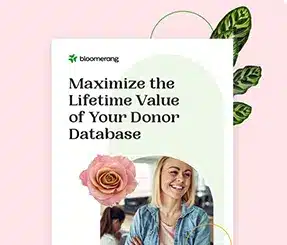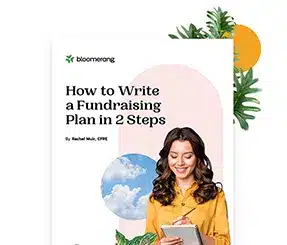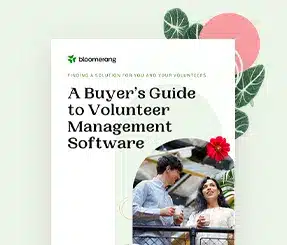Would Your Donor Experience Keep People Binging—or Make Them Hit Skip?
What fundraising teams can learn from the streaming playbook


Full Platform Overview Chat With Us



Full Platform Overview Chat With Us




A great donor retention strategy isn’t about doing more. It’s about designing an experience donors want to come back to.
If that sounds familiar, it should. Streaming platforms figured it out years ago: keep people watching by giving them just enough payoff to feel good—and just enough anticipation to keep them curious.
Nonprofits can apply the same thinking. Because when a donor makes that first gift, they’re not committing to a lifetime of giving. They’re pressing “play” on your story. And if what follows feels disjointed, impersonal, or inconsistent? They’re going to hit skip.
The good news: a binge-worthy donor experience isn’t about flashy production value or expensive perks. It’s about delivering value, building momentum, and giving people a reason to stay engaged.
That first gift doesn’t signal commitment—it signals interest. They liked what they saw enough to try an episode. Now the pressure’s on. The next thing they experience determines whether they come back.
📍 What makes them stick around:
▶️ What this looks like in action:
A new donor gives on a Tuesday. By Thursday, they’ve received a personalized thank-you note from a program leader and a short story that shows how their gift helped right away. Instead of wondering if their donation disappeared into a black box, they’re immediately pulled deeper into the mission.
Just under 14% of first-time donors give again. The welcome experience sets the tone for everything that follows.
▶️ What happens when it’s missing:
They give, get an automated receipt, and hear nothing else for two weeks—until the next ask. There’s no story, no context, no invitation. And just like that, the connection fizzles.
This is where many nonprofits lose their audience. After a strong opener, they go quiet—or jump straight to another appeal. But if your second touchpoint doesn’t build on the emotional momentum of the first, you’re not giving donors a reason to stay invested.
📍 What keeps the story moving:
▶️ What this looks like in action:
A follow-up message a few weeks later gives a genuine update—not a newsletter, but a curated experience. The donor is invited to a behind-the-scenes virtual tour or asked to weigh in on an upcoming initiative. It feels personal, like they’re part of what’s next.
Only 19% of first-time donors stick around—but retention jumps to 63% when they give again. That moment defines whether someone continues the donor journey—or drops off entirely.
▶️ What happens when it’s missing:
The next email is a mass update that makes no mention of their role in the story. Or worse, it’s another fundraising campaign, asking for more before the donor ever felt connected to the first gift.
Even loyal donors need to feel surprised now and then. Recognition is where the script usually flattens—generic thank-yous, templated messages, passive appreciation. But a thoughtful, unexpected gesture can reignite emotional connection.
For first-time donors, a message that feels like it was written just for them can set the tone for everything that follows. Small surprises go further than scripted gratitude.
📍 What makes recognition memorable:
▶️ What this looks like in action:
A donor gets a quick email on the anniversary of their first gift: “One year ago today, you changed someone’s story. Here’s what that impact looks like now.” Maybe they also get early access to a campaign preview or a call with a program lead. The message? You’re not just appreciated—you’re part of this.
One nonprofit, the Mara Elephant Project, increased retention by 15% by getting consistent—with thank-you emails, updates, and simple follow-ups that made people feel included.
▶️ What happens when it’s missing:
They’re included in the annual donor list or sent a generic thank-you email every December. Nothing about it reflects their journey. It’s technically recognition—but it doesn’t feel like it.
Too many nonprofits treat the renewal process like a subscription reminder. (“It’s that time of year again!”) But strong retention is like wrapping up the season with meaning—and setting the stage for what’s ahead.
📍 What makes the finale work:
▶️ What this looks like in action:
At the end of the year, the donor receives a personal year-in-review message: what they made possible, where your organization’s headed next, and a soft invitation to keep the story going. It feels earned, not transactional.
A 10% bump in retention doesn’t just stabilize revenue—it can double your donors’ lifetime value. That’s not just a nice-to-have. That’s the growth strategy.
▶️ What happens when it’s missing:
Donors get an impersonal renewal email or a matching gift appeal without acknowledging their past support. There’s no emotional closure—and no compelling reason to say yes again.
It’s not about one perfect episode. It’s about building something worth sticking around for.
The same is true in fundraising. A high-retention nonprofit does more than send better emails. It creates a rhythm of connection—something that feels intentional, personal, and aligned with your mission. Something that keeps donors choosing to engage.
If your donor experience had a “Next Episode” button, would they click it?
Retention is more than a thank-you email or an end-of-year push. It’s the full experience—from first gift to deeper connection, from curiosity to commitment. High-retention nonprofits don’t just keep donors giving. They keep them believing.
They design a journey with intent. Every touchpoint has a purpose. Every message builds trust. Every update moves the donor journey forward—reminding them why they showed up in the first place.
And over time, that consistency pays off. Donors move from one-time supporters to mission insiders—people who stay, advocate, and invite others in. That’s not luck. It’s a retention strategy rooted in purpose.
If your donor experience had a “Next Episode” button, would they click it?

Comments